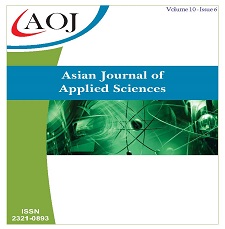New Modified Anderson Darling Goodness of Fit Test for Lognormal and Gamma distributions
DOI:
https://doi.org/10.24203/ajas.v10i6.7124Keywords:
Goodness of fit test, Anderson-Darling test, Kolmogorov Smirnov test, Modified Anderson-Darling testAbstract
The purpose of this study is to present the new modified Anderson-Darling goodness of fit test, and compare to the efficiency of three tests; Kolmogorov Smirnov test, Anderson-Darling test and Zhang (2002) test. A simulation study is used to estimate the critical values at a significance level of 0.05. The type I error rate and test power are calculated using Monte Carlo simulation with 10,000 replicates. The data are generated from the specified distribution; i.e., Lognormal and Gamma distributions with sample size of 10, 20, 30, 50, 100 and 200. The results demonstrate that every test has control over the type I error probability. The new test has the highest power for two alternative hypotheses; Loglogistic and Logistic distributions. Moreover, when the alternative distribution is Normal distribution and the sample size is small, the new test has the highest power.
References
Zhang, J. (2002). Powerful Goodness-of-Fit Tests Based on the Likelihood Ratio. Journal of the Royal Statistical Society Series B, 64(2), 281-294. DOI: 10.1111/1467-9868.00337
Cressie, N. & Read, T.M.C. (1984). Multinomial Goodness-of-Fit Tests. Journal of the Royal Statistical Society Series B, 46(3), 440-464. Available at: https://www.jstor.org/stable/2345686
Anderson, T.W. & Darling, D.A. (1952). Asymptotic Theory of Certain "Goodness of Fit" Criteria Based on Stochastic Processes. The Annals of Mathematical Statistics, 23(2), 193-212.
Anderson, T.W. & Darling, D.A. (1954). A Test of Goodness of Fit. Journal of the American Statistical Association, 49(268), 765-769.
Yodsima, R., Pongsakchat, V., Phuenaree, B. & Neamvonk, J. (2016). A study on the distributions of goodness of fit test statistics. Proceedings The 8th Science Research Conference. 135-141.
Morgan, E.C., Lackner, M., Vogel, R.M., & Baise, L.G. (2011). Probability distributions for offshore wind speeds. Energy Conversion and Management, 52(1), 15-26. doi:10.1016/j.enconman.2010.06.015
Dikko, H.G., David, I.J., & Bakari, H.R. (2013). Modeling the Distribution of Rainfall Intensity using Quarterly Data. IOSR Journal of Mathematics, 9(1), 11-16. DOI:10.9790/5728-0911116
Ximenes, P.S.M.P., Silva, A.S.A., Ashkar, F., & Stosic, T.(2021). Best-fit probability distribution models for monthly rainfall of Northeastern Brazil, 84(6), 1541-1556. DOI: 10.2166/wst.2021.304
Arthur, Y.D., Gyamfi, K.B. & Appiah, S.K. (2013). Probability Distributional Analysis of Hourly Solar Irradiation in Kumasi-Ghana. International Journal of Business and Social Research3(3), 63-75. DOI:10.18533/ijbsr.v3i3.57
Magenuka, T.K.M., Musasa, K. & Akindeji, K.T. (2020). Kernel Density Estimation of Solar Radiation and Wind Speed for South Africa. Proceedings of the 5th NA International
Downloads
Published
Issue
Section
License
Copyright (c) 2023 Jutaporn Neamvonk, Bumrungsak Phuenaree

This work is licensed under a Creative Commons Attribution-NonCommercial 4.0 International License.
- Papers must be submitted on the understanding that they have not been published elsewhere (except in the form of an abstract or as part of a published lecture, review, or thesis) and are not currently under consideration by another journal published by any other publisher.
- It is also the authors responsibility to ensure that the articles emanating from a particular source are submitted with the necessary approval.
- The authors warrant that the paper is original and that he/she is the author of the paper, except for material that is clearly identified as to its original source, with permission notices from the copyright owners where required.
- The authors ensure that all the references carefully and they are accurate in the text as well as in the list of references (and vice versa).
- Authors retain copyright and grant the journal right of first publication with the work simultaneously licensed under a Attribution-NonCommercial 4.0 International that allows others to share the work with an acknowledgement of the work's authorship and initial publication in this journal.
- Authors are able to enter into separate, additional contractual arrangements for the non-exclusive distribution of the journal's published version of the work (e.g., post it to an institutional repository or publish it in a book), with an acknowledgement of its initial publication in this journal.
- Authors are permitted and encouraged to post their work online (e.g., in institutional repositories or on their website) prior to and during the submission process, as it can lead to productive exchanges, as well as earlier and greater citation of published work (See The Effect of Open Access).
- The journal/publisher is not responsible for subsequent uses of the work. It is the author's responsibility to bring an infringement action if so desired by the author.


